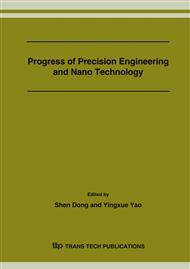p.1
p.6
p.11
p.16
p.21
p.26
p.32
Research on Influence of the Cutter Rake Angle to the Surface Quality during SPDT Machining of Crystal KDP
Abstract:
Influence of the cutter rake angle to the surface quality of crystal KDP is analyzed theoretically in this paper. Analysis result shows that the tension stress reaches minimum in the crystal KDP cutting region and optimal value of the surface quality is obtained as cutter rake angle is about -45°. Cutting experimental of different cutter rake angle is realized on the machine tool. Experimental results show that the surface roughness of the crystal KDP reach minimum (rms is 6.521nm, Ra is 5.151nm) as the cutter rake angle is about -45°, this experiment certifies the correctness of this theory analysis. Theory analysis and experimental results show that influence of the cutter rake angle to surface quality of the crystal KDP is very large, for ultra-precision machining of the crystal KDP, when large negative rake diamond cutter (-45°) is adopted, the super-smooth surface can be obtained.
Info:
Periodical:
Pages:
1-5
Citation:
Online since:
May 2007
Authors:
Keywords:
Price:
Сopyright:
© 2007 Trans Tech Publications Ltd. All Rights Reserved
Share:
Citation:


